Table of Contents
Dun Pea Microgreens
Over the past few years, I've developed a deep appreciation for the culinary wonders of microgreens. Among the many varieties that have sparked my curiosity and delighted my taste buds, Dun Pea microgreens stand out as a true gem.
These little greens have not only added a burst of flavor to my dishes but also brought a vibrant pop of color to my culinary creations. In this guide, I want to share my journey and insights into the world of Dun Pea microgreens – from how I cultivate them at home to the amazing health benefits they offer and the creative ways I've incorporated them into my cooking adventures.
What are Dun Pea Microgreens?
Dun Pea microgreens, also known as Dun pea shoots step growing or Dun Pea sprouts, offer a fascinating glimpse into the world of culinary greens. These miniature wonders are derived from the Dun Pea plant (Pisum sativum var. arvense) when it is in its early stages of growth. Typically, they are harvested when the seedlings reach the cotyledon stage, measuring just a few inches in height and brimming with delectable flavors.
These microgreens are distinguished by their delicate, lacy leaves and their vibrant, lush green hue. Their petite size and aesthetic appeal make them an enticing addition to various culinary creations, from salads to sandwiches and beyond.
Delving into the historical context, the cultivation of Dun Pea microgreens possesses a rich heritage spanning centuries. Peas, including Dun Peas, have been cultivated and consumed for millennia, with the practice of growing them as microgreens gaining prominence in more recent times.
In ancient civilizations, peas were prized as a fundamental crop owing to their exceptional nutritional composition. Today, Dun Pea microgreens continue this legacy, revered not only for their remarkable health benefits but also for their adaptability in the culinary realm.
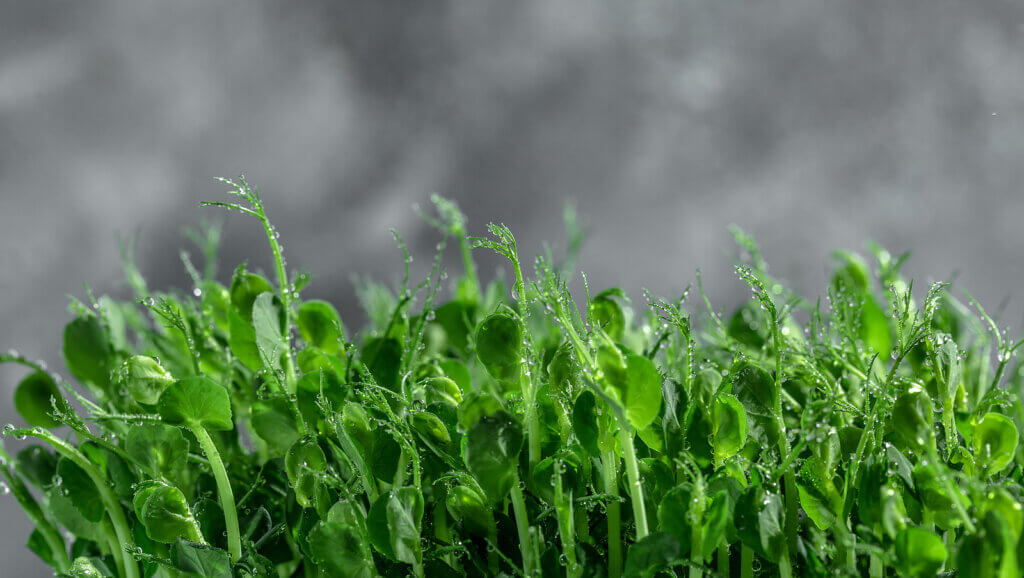
Cultivating Dun Pea Microgreens
Equipment and Supplies
To ensure successful Dun Pea microgreen cultivation, it's crucial to start by gathering the following equipment and supplies, which play a vital role in the growth and care of your microgreens:
- Seeds: Begin with high-quality Dun Pea seeds obtained from a reputable source. The quality of your seeds significantly impacts the outcome of your microgreens.
- Growing Trays or Containers: Choose shallow trays or containers equipped with proper drainage holes. These containers provide the necessary space for your seeds to grow, while drainage holes prevent waterlogged soil, promoting healthy root development.
- Growing Medium: Select an appropriate growing medium, such as a well-balanced potting mix or a soilless alternative. The growing medium should provide essential nutrients and support optimal moisture retention.
- Watering Can or Spray Bottle: To maintain the ideal moisture levels for your microgreens, have a watering can with a fine spray nozzle or a spray bottle on hand. This allows you to gently hydrate your microgreens without disturbing their delicate growth.
- Light Source: Adequate light is crucial for the photosynthesis and healthy development of your Dun Pea microgreens. Depending on your setup, you can rely on natural sunlight or invest in grow lights designed for optimal plant growth.
- Thermometer and Hygrometer: Monitor the environmental conditions in your growing space with a thermometer and hygrometer. Maintaining the right temperature and humidity levels is essential for the success of your microgreens.
- Labels: Keep organized records of your microgreen batches by using labels. Label each tray or container with planting dates and seed varieties. This helps you track the progress of your microgreens and identify any specific preferences or traits associated with different seed varieties.
Growing Medium
Choosing the appropriate growing medium is a critical step in ensuring the successful cultivation of Dun Pea Microgreens. The right growing medium not only influences the growth and development of your microgreens pea shoots fresh organic but also plays a significant role in overall plant health. Here's a more detailed explanation of the options and considerations:
Soilless Mix
Opting for a soilless mix is a highly recommended choice for Dun Pea Microgreens. These mixes are typically composed of a blend of materials such as peat moss, coconut coir, vermiculite, and perlite. They offer several advantages, including:
- Good Drainage: Soilless mixes have excellent drainage properties, reducing the risk of overwatering and root rot. This is especially important for microgreens, which are susceptible to moisture-related issues.
- Aeration: The inclusion of perlite or vermiculite in soilless mixes ensures adequate aeration, promoting healthy root development and preventing compaction of the growing medium.
- Sterility: Soilless mixes are often sterile or pasteurized, minimizing the risk of soilborne diseases or pests affecting your microgreens.
Coconut Coir and Perlite Blend
Another effective option for your Dun Pea Microgreens is a combination of coconut coir and perlite. Coconut coir is a sustainable and organic growing medium made from coconut husks. When blended with perlite, it provides:
- Excellent Moisture Retention: Coconut coir retains moisture well, ensuring consistent hydration for your microgreens without becoming waterlogged.
- Lightweight Texture: The addition of perlite lightens the mixture, preventing compaction and allowing for optimal aeration.
- Sustainability: Coconut coir is an eco-friendly choice, making it a suitable option for environmentally conscious growers.
Planting and Germination
To kickstart the Dun Pea microgreen cultivation process successfully, follow these detailed steps for planting and germination:
- Pre-soak the Seeds: Begin by soaking your Dun Pea seeds in water for an optimal period of 6-8 hours. This soaking period serves to hydrate the seeds and trigger the germination process effectively.
- Sow the Seeds: Once adequately soaked, evenly distribute the pre-soaked seeds onto the chosen growing medium. Strive for a dense but not overcrowded layer of seeds to encourage robust growth.
- Cover and Press: After laying the seeds, lightly cover them with a thin layer of the chosen growing medium. Gently press down on the surface to ensure good seed-to-soil contact. This step enhances the seeds' access to nutrients and moisture in the medium.
- Watering: Maintain the moisture levels by using a spray bottle to mist the surface. The goal is to keep the growing medium consistently moist without allowing it to become waterlogged, which can hinder germination.
- Germination: For optimal germination, place the trays or containers in a warm location with indirect sunlight. Maintain the ambient temperature within the range of 70-75°F (21-24°C). Germination typically begins within 3-5 days under these favorable conditions.
Light and Temperature Requirements
Light and temperature play crucial roles in the successful cultivation of Dun Pea microgreens. These delicate greens flourish best when exposed to a consistent regimen of 12-16 hours of light per day. When employing artificial grow lights, it is advisable to position them within a proximity of 2-4 inches above the microgreens to ensure they receive an optimal light intensity.
Furthermore, the temperature conditions for Dun Pea microgreens must be carefully controlled to achieve optimal growth. They thrive in a temperature range of 60-75°F (15-24°C).
Maintaining this temperature range is essential for promoting healthy development and robust yields of these microgreens. It's worth noting that deviations from these temperature and light requirements may result in slower growth and less desirable crop outcomes.
Watering and Humidity
Effective watering and humidity control are crucial factors in ensuring the healthy development of your plants. It is essential to maintain consistent moisture levels throughout the entire growth cycle to promote optimal growth and prevent potential issues like mold or rot.
When it comes to watering, it is important to strike the right balance. Avoid overwatering, as excess moisture can create a favorable environment for fungal growth and root rot. Instead, utilize a gentle spray bottle to administer water to your plants, providing them with the necessary hydration without drowning their roots.
Furthermore, monitoring the relative humidity in your growing environment is key to your plant's well-being. A hygrometer is a valuable tool that can help you maintain the ideal humidity range of 40-60%.
This range ensures that your plants receive the appropriate atmospheric conditions for healthy growth, avoiding problems associated with excessively dry or overly humid environments. By diligently managing both watering and humidity, you can promote thriving, vigorous plants throughout their life cycle.
Harvesting
Harvesting Dun Pea microgreens is a crucial step in their cultivation process, ensuring you get the most flavor and nutrition from these tiny greens. These delicate microgreens are typically ready for harvest when they reach a height of 2-3 inches and have developed their first true leaves. To achieve the best results:
- Timing is Key: Keep a close eye on your Dun Pea microgreens as they grow. Once they have reached the specified height and the first true leaves have emerged, it's time to harvest. This stage usually occurs about 10-14 days after planting the seeds.
- Tools for Harvest: Use clean and sharp scissors or shears for the harvest. Make sure they are sanitized to prevent any contamination. A clean cut ensures a quicker recovery for the remaining plants.
- Cutting Technique: Position the scissors just above the soil line, and with a gentle snip, remove the microgreens. Take care not to damage the neighboring plants or roots while doing so.
- Post-Harvest Care: After harvesting, it's essential to maintain the quality of your Dun Pea microgreens. Start by giving them a gentle rinse under cool, running water to remove any residual soil or debris. Pat them dry using a clean kitchen towel or paper towels. This step helps to preserve the freshness and prevent moisture-related issues.
- Immediate Use: Dun Pea microgreens are at their peak in terms of flavor and nutrition when freshly harvested. Therefore, it's ideal to use them immediately in salads, sandwiches, wraps, or as a garnish for various dishes to enjoy their vibrant taste and nutritional benefits.
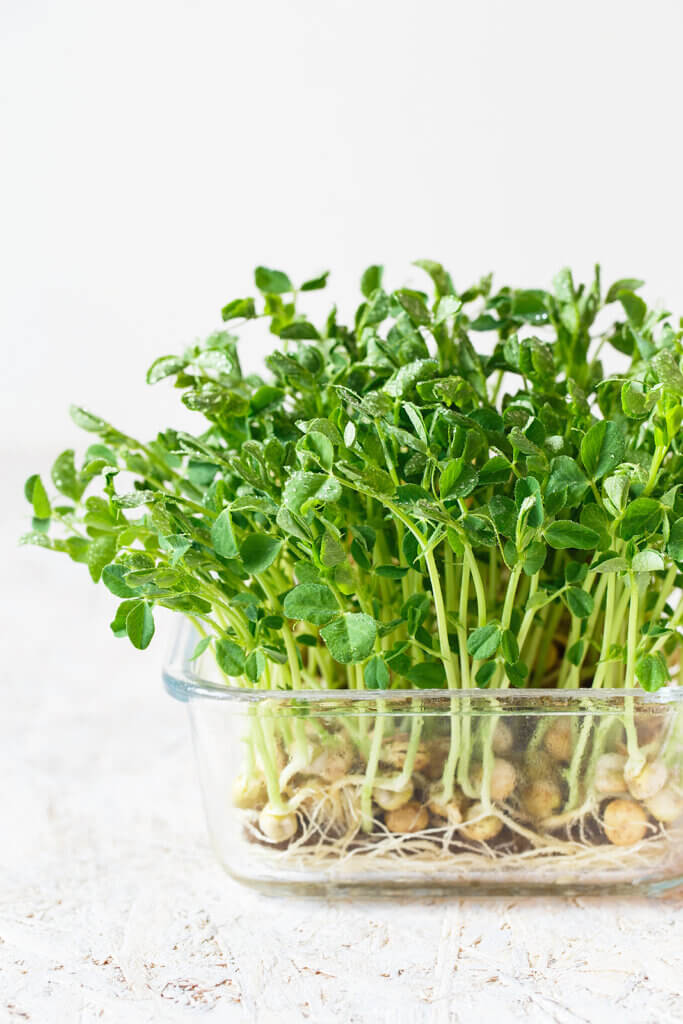
Nutritional Value and Health Benefits
Nutrient Profile
Dun Pea microgreens are an exceptional source of essential nutrients, making them a valuable addition to your diet. These vibrant greens offer a diverse range of vitamins, minerals, and other health-promoting compounds, including:
- Vitamin C: These microgreens are packed with vitamin C, known for its immune-boosting properties. It also plays a crucial role in maintaining healthy skin and combating oxidative stress.
- Vitamin K: Dun Pea microgreens are abundant in vitamin K, which is essential for blood clotting and contributes to overall bone health. It aids in the formation of strong bones and helps prevent fractures.
- Fiber: Including Dun Pea microgreens in your meals is an excellent way to enhance your fiber intake. Fiber promotes digestive health by aiding in regular bowel movements and can contribute to maintaining a healthy weight by promoting a feeling of fullness.
- Folate (Vitamin B9): These microgreens are a rich source of folate, a crucial nutrient for cell division and DNA synthesis. It is especially important during pregnancy to support the growth and development of the fetus.
- Iron: Dun Pea microgreens contain iron, a vital mineral that supports the transport of oxygen throughout the body. Iron is essential for preventing anemia and ensuring proper energy production.
Antioxidant Properties
Dun Pea microgreens boast an impressive array of antioxidants, including carotenoids and flavonoids, renowned for their exceptional ability to neutralize harmful free radicals within the body. These antioxidants play a pivotal role in safeguarding against the development of chronic diseases, notably heart disease and cancer. By diligently countering oxidative stress, Dun Pea microgreens contribute significantly to promoting overall health and well-being.
Health Benefits
Dun Pea microgreens, tiny but mighty in nutritional value, offer a plethora of health benefits for those who incorporate them into their diets. These vibrant green sprouts are packed with nutrients and have been linked to a range of positive effects on well-being, including:
- Improved Digestion: Dun Pea microgreens are a fantastic source of dietary fiber, which is essential for maintaining a healthy digestive system. Fiber aids in regular bowel movements, preventing constipation, and promoting a smoother digestive process.
- Enhanced Immunity: These microgreens are rich in vitamin C, a potent antioxidant known for its immune-boosting properties. By bolstering the body's immune system, vitamin C helps fend off illnesses and infections, keeping you feeling your best year-round.
- Better Heart Health: Dun Pea microgreens are a heart-healthy choice due to their combination of antioxidants and fiber. Antioxidants help reduce oxidative stress, which can lead to the development of heart disease. Additionally, the fiber in microgreens can contribute to lower cholesterol levels, reducing the risk of cardiovascular issues.
- Support for Bone Health: Vitamin K, found abundantly in Dun Pea microgreens, is vital for bone health. This nutrient assists in calcium absorption and helps in the production of proteins necessary for maintaining strong and healthy bones. Regular consumption of these microgreens may contribute to a decreased risk of conditions like osteoporosis.
Adding Dun Pea Microgreens to Your Diet
Dun Pea microgreens are a nutritious and flavorful addition to your meals. These tiny greens are packed with vitamins and minerals, making them a great choice for those looking to boost their diet's nutritional value. Here are several creative ways to incorporate Dun Pea microgreens into your daily meals:
- Salads: Elevate the freshness and flavor of your salads by tossing a handful of Dun Pea microgreens into the mix. Their tender, delicate leaves add a unique texture and a burst of nutrition to your greens.
- Sandwiches and Wraps: Transform your sandwiches and wraps into healthy and vibrant creations by using Dun Pea microgreens as a colorful garnish. Not only do they enhance the visual appeal of your meals, but they also provide a crunchy, nutrient-rich element.
- Smoothies: Start your day with a nutritious kick by blending Dun Pea microgreens into your morning smoothie. These greens not only add a refreshing taste but also contribute essential vitamins and minerals, making your smoothie even more beneficial for your health.
- Garnish: Elevate the presentation and taste of various dishes by using Dun Pea microgreens as a finishing touch. Sprinkle them on soups, omelets, or pasta dishes to infuse a subtle, earthy flavor and a vibrant touch of green.
- Sushi Rolls: Give your homemade sushi rolls a twist by incorporating Dun Pea microgreens as a filling or garnish. Their fresh and crisp texture pairs well with sushi's traditional ingredients, adding a delightful crunch and nutritional value to your rolls.
Culinary Delights with Dun Pea Microgreens
Flavor Profile
Dun Pea microgreens, these petite but flavorful greens, are a culinary delight. Their flavor profile is characterized by a delicate and refreshing taste, offering a mild sweetness complemented by subtle earthy undertones. This unique combination makes Dun Pea microgreens an exceptionally versatile ingredient that can enhance a wide range of culinary creations, whether savory or sweet.
Recipes
Dun Pea Microgreen Salad: Ingredients
- Fresh Dun Pea microgreens
- Cherry tomatoes
- Cucumber slices
- Red onion slices
- Crumbled Feta cheese
- Balsamic vinaigrette dressing
Instructions
Create a vibrant Dun Pea Microgreen Salad by tossing together a generous handful of Dun Pea microgreens with juicy cherry tomatoes, crisp cucumber slices, thinly sliced red onions, and crumbled Feta cheese. Finish it off with a drizzle of tangy balsamic vinaigrette to experience a refreshing and flavorful salad.
Dun Pea Microgreen Pesto: Ingredients
- Fresh Dun Pea microgreens
- Garlic cloves
- Roasted pine nuts
- Grated Parmesan cheese
- High-quality olive oil
- Freshly squeezed lemon juice
- Salt and freshly ground black pepper
Instructions
Elevate your pasta dishes or sandwiches with the vibrant Dun Pea Microgreen Pesto. Simply blend together Dun Pea microgreens, garlic cloves, roasted pine nuts, grated Parmesan cheese, high-quality olive oil, freshly squeezed lemon juice, salt, and freshly ground black pepper until smooth. The resulting pesto can be used as a flavorful pasta sauce or spread on your favorite sandwiches.
Dun Pea Microgreen Smoothie: Ingredients
- Fresh Dun Pea microgreens
- Ripe banana
- Creamy Greek yogurt
- Natural honey
- Nutrient-rich almond milk
Instructions
Start your day with a nutritious and refreshing Dun Pea Microgreen Smoothie. Blend together a handful of fresh Dun Pea microgreens, a ripe banana, creamy Greek yogurt, a drizzle of natural honey, and nutrient-rich almond milk. This green smoothie is not only delicious but also packed with essential nutrients, making it a fantastic addition to your morning routine.
Pairings with Other Foods
Pairing Dun Pea microgreens with a diverse range of foods can elevate your culinary experience by imparting unique flavors and textures. These microgreens complement a wide array of ingredients, making them a versatile addition to your dishes. Here are some exciting pairings to explore:
- Proteins: Dun Pea microgreens enhance the taste and presentation of proteins. Try them alongside succulent chicken, flavorful salmon, delicate shrimp, or even tofu for a vegetarian option. Their crispness and earthy notes add depth to your protein-based dishes.
- Cheeses: Elevate your cheese platter or cheese-based recipes by including Dun Pea microgreens. Their mild, grassy flavor pairs wonderfully with a variety of cheeses. Consider serving them with creamy goat cheese, gooey mozzarella, or bold blue cheese to create a harmonious balance of tastes and textures.
- Grains: Dun Pea microgreens can transform your grain-based dishes into gourmet delights. Incorporate them into your quinoa salads, rice bowls, or couscous dishes. Their fresh and crunchy texture complements the grains' softness while adding a vibrant burst of flavor.
- Fruits: Dun Pea microgreens also work surprisingly well with fruits, creating a delightful blend of sweet and savory. Experiment with combinations like strawberries and microgreens for a fresh and zesty contrast, oranges and microgreens for a tangy twist, or apples and microgreens for a crisp and refreshing experience.
Tips for Success and Troubleshooting
When cultivating Dun Pea microgreens, it's essential to be aware of potential challenges and strategies for maximizing their growth and flavor while maintaining their health step growing pea shoots. Here are some valuable insights to help you achieve success with your Dun Pea microgreen crop:
Common Issues and How to Address Them:
- Overwatering: Dun Pea microgreens are susceptible to rot if they are overwatered. To avoid this issue, make sure the growing medium remains consistently moist but not waterlogged. Be mindful not to saturate the soil.
- Leggy Growth: If your microgreens appear tall and spindly, it's a sign they may not be receiving enough light. Adjust the light source by placing it closer to the plants or consider providing additional light if natural sunlight is insufficient.
Pest and Disease Management:
- Aphids: If you notice aphids infesting your Dun Pea microgreens, a gentle spray of water can be an effective way to remove them. Be thorough in rinsing the microgreens to eliminate these pests and prevent further damage.
- Mold or Mildew: Proper air circulation is crucial to prevent mold or mildew growth. Ensure good ventilation around your microgreens and avoid overwatering, as excess moisture can encourage these issues. Maintain a balanced humidity level in your growing environment.
Maximizing Flavor and Nutrient Content:
To enjoy the tastiest and most nutrient-rich Dun Pea microgreens, follow these guidelines:
- Harvest at the Right Stage: Wait until your microgreens have developed their first true leaves before harvesting. This stage ensures optimal flavor and nutritional content.
- Consume Fresh: To enjoy the peak freshness and nutrition of your dun pea microgreens seeds, consume them as soon as possible after harvesting. Incorporate them into your meals to experience their vibrant flavors and health benefits.
Conclusion
In my personal culinary journey, Dun Pea microgreens have become a cherished discovery. These little greens have not only adorned my dishes with their delicate flavors and vibrant colors but have also offered a window into the joys of cultivation. Nurturing them from seed to harvest has taught me patience and the rewards of tending to living things, making the entire process incredibly fulfilling.
Beyond their aesthetics, Dun Pea microgreens have impressed me with their nutritional prowess. Their abundance of vitamins, minerals, fiber, and antioxidants contributes to my overall well-being, boosting immunity, supporting heart health, and enhancing digestion shoots step growing pea.
As I continue to experiment with these microgreens in various recipes, from salads to smoothies, their unique flavor profile adds a touch of mild sweetness and earthiness to my culinary creations. My journey with Dun Pea microgreens has not only enriched my palate but also deepened my appreciation for the simple pleasure of growing and savoring nature's bounty.

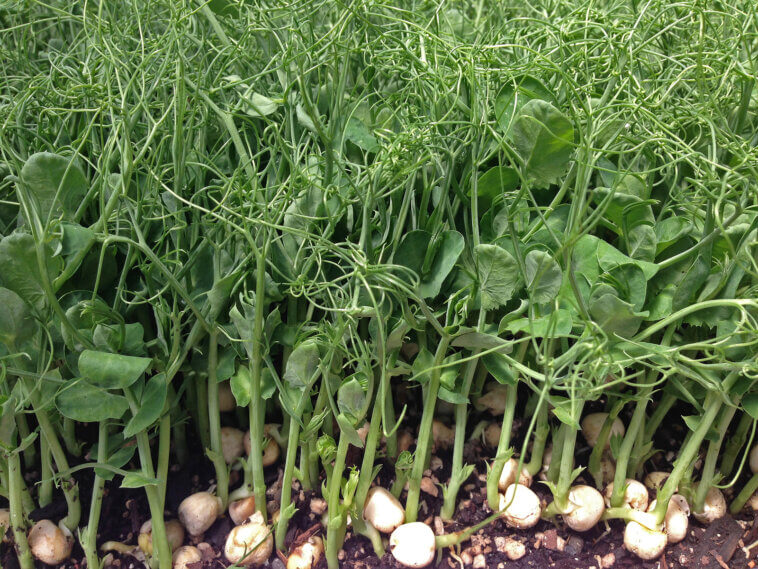
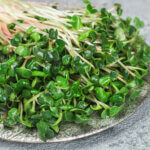
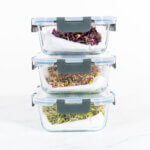
Comments
Loading…